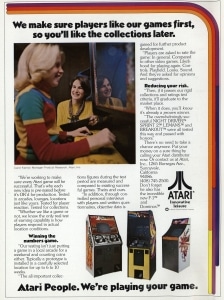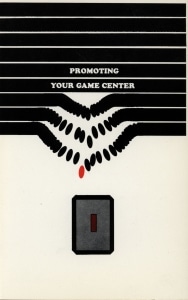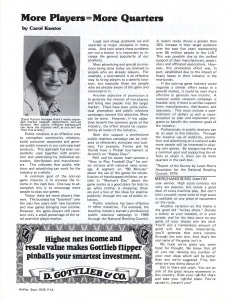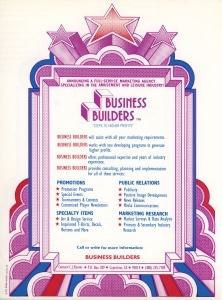 How do you know if a game will be a hit or a flop with players? According to legend, video game pioneer Atari knew their 1972 coin-operated video game Pong would be a winner because players filled the test game’s coinbox with so many quarters that it jammed up the machine. As any veteran of the arcade game industry will tell you: “The coin box never lies.” But surely there should be more to it than that? In 1976, Atari vice president Gene Lipkin hired Carol Kantor to help the company answer that question. Kantor would be charged with forecasting a game’s success in a way that would not solely rely on coin-collection data. In meeting that goal, she revolutionized how Atari made games and developed the industry’s earliest user research program.
How do you know if a game will be a hit or a flop with players? According to legend, video game pioneer Atari knew their 1972 coin-operated video game Pong would be a winner because players filled the test game’s coinbox with so many quarters that it jammed up the machine. As any veteran of the arcade game industry will tell you: “The coin box never lies.” But surely there should be more to it than that? In 1976, Atari vice president Gene Lipkin hired Carol Kantor to help the company answer that question. Kantor would be charged with forecasting a game’s success in a way that would not solely rely on coin-collection data. In meeting that goal, she revolutionized how Atari made games and developed the industry’s earliest user research program.
When Carol Kantor started at Atari, she had already earned degrees in business statistics, computer science, and management science and marketing. She drew on that education and brought with her what she learned working in the consumer product divisions of the Clorox Company and Fairchild Camera and Instrument Corporation. She took consumer market research techniques, including observations of customers, focus groups, and surveys, and for the first time applied them to video game development. Although some at Atari were skeptical of this new research approach, the results of Kantor’s research won over her colleagues. As she told author Meagan Marie in her book Women in Gaming: 100 Professionals of Play, “My favorite times were when game development engineers came to observe players in the field and actually saw the results of observation.”
In 1977, Kantor’s success led Atari to make a major investment in market research. She hired Colette Weil, Mary Takatsuno (later Fujihara), and Linda Butcher (later Adam) and formed the company’s (and the game industry’s) first market research group. Together, the team observed and studied player behavior on location in arcades and bars, gathered teenage and adult player feedback through focus groups, and created a comparative database of player surveys. Colette Weil would even write her MBA thesis, on the motivations of male and female arcade game players. Through Kantor and her team’s efforts, Atari integrated this new approach to player research into the development of all its arcade video games.
Kantor also wrote about and shared some of her research methods and promotional strategies with the wider coin-op industry through various publications. In late 1976, she created and edited Atari Coin Connection, a newsletter aimed at arcade operators and distributors. Soon she began writing articles for coin-op industry trade magazines RePlay and Play Meter. In one of her earliest pieces, titled “More Players = More Quarters” (RePlay, September 1976) she called for an industrywide, professional public relations campaign to combat “legal and image problems” and “bring new people into the target market.” In other articles, she highlighted the importance of positive publicity, advertising, and promotions such as tournaments and giveaways. True to her roots, however, she also continued to emphasize the usefulness of getting players’ opinions—talking directly to players themselves to get their feedback about games and an arcade owner’s location.
In 1979, Kantor left Atari to go out on her own. She founded Business Builders, a marketing agency specializing in the amusement and leisure industry. Although Atari was her first customer, she carried out research and created newsletters, advertising, publicity, and promotional programs and items for arcade game manufacturers, distributors, and location owners (as well as others outside the game industry). She also shared many insights in her 1982 book Promoting Your Game Center, which provided advice to arcade owners on topics ranging from a game center’s name, logo, and positive publicity plans to clubs, contests, and coupons meant to encourage loyalty and engage new players. Four decades later, Kantor and Business Builders still helps an array of businesses with branding, logo design, and promotion.
 Today, when many of us think about the people who helped build the video game industry, we often recall game executives who founded and steered companies and game designers and programmers who carefully crafted digital worlds. But Carol Kantor and the women who formed the first video game market research team helped lay an important foundation for game user researchers, which have become crucial parts of game development in the 21st century. Alongside The Strong’s Atari Coin-op Divisions Collection, the addition of Carol Kantor’s papers to the museum’s archives helps us preserve materials that document the work of the video game industry’s first game user researchers.
Today, when many of us think about the people who helped build the video game industry, we often recall game executives who founded and steered companies and game designers and programmers who carefully crafted digital worlds. But Carol Kantor and the women who formed the first video game market research team helped lay an important foundation for game user researchers, which have become crucial parts of game development in the 21st century. Alongside The Strong’s Atari Coin-op Divisions Collection, the addition of Carol Kantor’s papers to the museum’s archives helps us preserve materials that document the work of the video game industry’s first game user researchers.
 Hours 10 a.m.–5 p.m. | Fri. & Sat. till 8 p.m.
Hours 10 a.m.–5 p.m. | Fri. & Sat. till 8 p.m.

